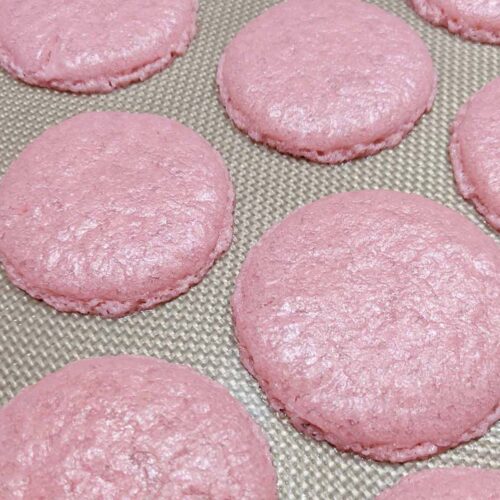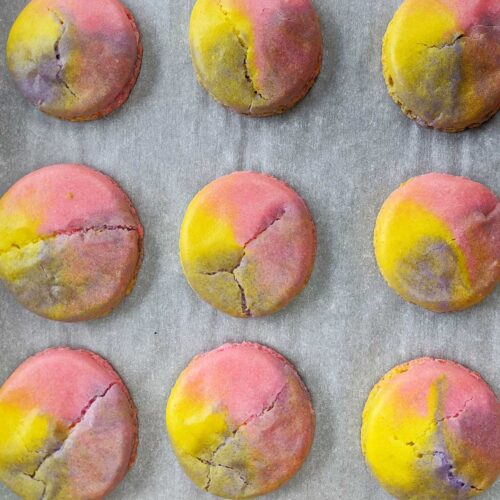Wondering why your macarons have wrinkled tops? Check out this troubleshooting guide teaching you how to fix wrinkly macaron shells.

Want To Save This Article?
Enter your email below and we'll send it straight to your inbox. Plus, you'll receive new weekly recipe inspiration.
I love baking macarons, but undoubtedly, I've run into issues along the way. Macarons are known for being finicky desserts that even the best pastry chefs mess up from time to time.
In this guide, I want to help you solve the issue of why your macarons have wrinkled tops. I'll teach you the top issues related to equipment, technique, and ingredients that could be leading to wrinkled macaron shells.
As always, remember that it takes some trial and error to bake macarons at home. Don't give up on your first or second attempt, keep going!
You can always refer to my macaron troubleshooting video or leave a comment below and I'll do my best to help you out.
Jump to:

What You'll Learn In This Article
- How low oven temperature may be causing wrinkled macarons.
- The crucial techniques you must learn in order to avoid wrinkly macaron shells.
- Some ingredients that may be causing wrinkled tops. This is especially helpful if you're developing your own macaron recipe.
If you are looking for some more specialized help with troubleshooting your macaron problems, sign up for my free macaron troubleshooting guide sent straight to your email.
Equipment Related Issues
The equipment you're using could be causing your macarons to have wrinkled tops. Here are some common equipment-related issues you should check:
1. Oven temperature: Oven temperature is one of the most common macaron-related issues, especially for experienced macaron bakers who have recently started using a new oven. You can read more about my experiments with oven temperature if you're curious to learn more.
With wrinkled macarons, the most likely culprit is low oven temperature. To remedy this, you'll first need to purchase an oven thermometer.
It's important to understand your oven may not be heating to the temperature you set it to. To test this, place the oven thermometer in the center rack of your oven and double-check the temperature reading before baking the macarons.
Next, you'll need to play around with your temperature settings. I usually recommend heating your oven to 300°F (150°C) and adjusting from there. Pipe a set of 4 - 6 macarons on a baking sheet and test just a few macarons at a time (so you don't ruin a whole batch).
If you find that 300°F (150°C) is resulting in wrinkled macarons, this means your oven temperature is too low. Bump your temperature up 5°F (3°C), wait for the oven thermometer to read the correct temperature, and then try baking another set of 4 - 6 macarons.
Continue this process, baking a small set of macarons at a temperature 5°F (3°C) higher until you no longer see wrinkled macaron tops.
If low oven temperature is your problem, you'll also likely notice that your macaron shells are too chewy or the shell is very weak.

2. Oily Equipment: If you're familiar with making meringue, you know that any type of fat can hinder the aeration of the egg whites. This can lead to an under whipped meringue.
There may be fat (like butter or oil) on your equipment if it hasn't been washed well enough.
To fix this, simply take a paper towel and pour a bit of white vinegar on it. Wipe down your mixing bowls and mixer whisk attachment to ensure any excess oil has been removed.
This will ensure your meringue whips perfectly to fully stiff peaks.

Technique Related Issues
There are many technique-related issues that could be causing your macarons shells to wrinkle in the oven:
1. Under whipped or over whipped meringue: One of the most important techniques to learn, especially when making macarons, is how to whip egg whites to stiff peaks.
Egg whites that are under whipped or over whipped can result in wrinkled shells, weak tops, and macarons that will not properly rise.
In order to achieve stiff peaks, you need to learn the visual cues you can use to know that your meringue has whipped to stiff peaks:
- You'll notice the meringue starts to ball up inside the whisk while it's mixing.
- Pull the whisk out of the mixer. A stiff peak should stand straight up (no curl at the tip).
- You can see pointy off-shoots of egg whites on the whisk when you pull it out of the mixer.
- You can fully flip the bowl over and nothing moves or falls out.
- The meringue feels sturdy (not flimsy).
- The egg whites hold the indentation that the whisk makes as it's whipping.
It typically takes around 8 - 10 minutes to reach stiff peaks, depending on your mixer and the speed. I use a KitchenAid mixer on speed 7.
Additionally, if you're making French style meringue macarons, make sure to slowly add the granulated sugar during the whipping process. This allows the sugar crystals time to dissolve so they don't weigh down the egg whites.
If the sugar is added too quickly, it can affect the final structure, resulting in an under whipped and weak meringue.

2. Over macaronaged: Another common issue related to wrinkly macaron shells is over macaronaging.
Macaronage is a term that refers to folding the dry macaron ingredients (almond flour and confectioners' sugar) into the meringue. This process smooths the mixture and helps the macarons bake with proper structure.
To properly macaronage, you should fold the batter until it reaches a lava-like consistency. You can test this by lifting your spatula and seeing if the batter drops almost like lava. Once it drops off the spatula, the batter that was dripped should fade back into the batter within 15-30 seconds.
Additionally, the almond flour should look blended into the meringue (not lumpy).
Many home bakers who are new to baking macarons will over macaronage. When in doubt, it's better to under macaronage rather than over macaronage.
You'll eventually learn the proper consistency of macaronaged batter, which will make the macaron baking process easier!

Ingredient Related Issues
Here are some reasons your macaron ingredients could be leading to wrinkled tops:
1. Oily ingredients: There are two things to look out for in this category.
First, fat could be present if you accidentally allowed any of the egg yolks to mix with the egg whites. This causes oil in the meringue, which as we previously talked about, can cause the meringue to be under whipped.
Next, almond flour that's too oily may be causing you some issues. Most finely ground almond flour like Bob's Red Mill or Blue Diamond shouldn't normally be too oily right out of the bag (although there could be a rare case of this).

2. Too much liquid: If you're developing a macaron recipe and running into wrinkled or cracked macaron shells, you may be using too much egg white.
To combat this issue, you can lower the amount of egg whites in the recipe.
Alternatively, try aging the egg whites. To age egg whites you'll separate the egg whites from the yolks 2 - 5 days before baking the macarons. Place the egg whites in a container covered with plastic wrap.
Poke a couple of holes in the plastic wrap, and place the eggs back in the refrigerator. This allows some of the water to evaporate in the fridge.
Once you're ready to bake, allow the egg whites to come to room temperature before whipping them into meringue.

3. Cocoa powder: Cocoa powder can be another cause for wrinkled or cracked macarons. If you're developing a recipe, you'll need to consider this option.
Cocoa powders have fat from cocoa butter. Different brands can have different amounts of fat, depending on how much cocoa butter has been added.
Too much fat (oil), as we know, can affect the final texture of the macarons. If you're making a chocolate-based macaron with too much cocoa powder, this could be causing a wrinkly or cracked top.
Try adjusting the amount of cocoa powder you're using, or use a brand with less fat content. I've seen many recommendations for Hershey’s cocoa powder as a good brand to use.

Expert Tips
- Only bake one tray of macarons at a time. This can also help you pinpoint any issues you may be having related to oven temperature.
- Always use an oven thermometer to ensure your oven is properly heating since this is the cause of many wrinkled macarons.
- If you're having trouble with under whipped meringue, you should consider using a different type of meringue for your macarons. Both Swiss and Italian meringue macarons are known for being more stable.
FAQs
There are many different reasons why your macaron shells could have wrinkly tops. Here are a few common reasons:
- Your oven temperature is too low.
- You have oil on your equipment.
- The meringue is under or over whipped.
- You over macaronaged the macaron batter.
- There's too much liquid in the batter.
- You're using cocoa powder with too much fat.
Likely, if your macarons are just a tad wrinkly, you'll need to adjust your oven temperature. If your oven is a little too cold or even a little too hot, it can cause slight wrinkles on your macaron shells.
If your macarons looked more cracked instead of wrinkled, you may be experiencing some of the following issues:
- Your oven temperature is too hot.
- You under or over whipped your meringue.
- You over macaronaged the batter.
- You didn't allow the macarons to rest long enough to form a proper skin.
- There were air bubbles trapped in the macaron shells.
Check out this cracked macaron troubleshooting guide instead.
More Macaron Troubleshooting Guides
Love this guide? Please leave a comment below. Don't forget to follow along on Instagram, Facebook, YouTube, and Pinterest for more recipes.












Leave a Reply